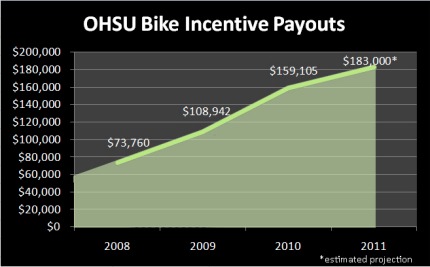
How do you encourage people to bike to work? Simple. Cold hard cash.
Since 2005, Oregon Health & Science University has used cash incentives to encourage their employees to bike to work. Between 2008 and 2011 alone, OHSU will have given out over $523,00 through their Bike Incentive Program.
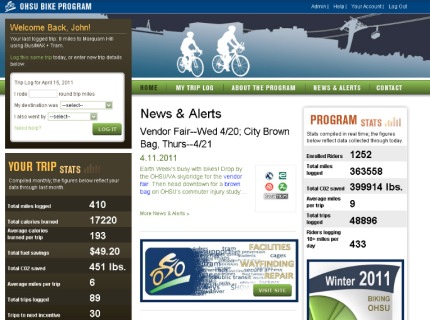
The program encourages employees to use a bicycle for at least two miles of their commute (so as to encourage multi-modal trips as well). OHSU also provides a dedicated website for participants to log their trips and keep track of their progress (the site is open to employees only). The web portal also has an interactive map of bicycling facilities on OHSU’s sprawling campus in the hills just south of downtown Portland.
Bike commuters can get up to $50 cash for every 30 trips logged.
For every 30 bike trips logged, participants can choose from one of three incentives; either a reimbursement of one month’s worth of car parking (if they also drive), $35 if they also get a transit pass subsidy, or if they bike and do not partake in the transit or car parking programs, participants receive $50. (Learn more about the program in this PDF.)
In addition to cash, OHSU also provides secure bike parking, access to showers, free tubes, access to tools, and free route maps.

(Photos © J. Maus)
John Landolfe, who works in OHSU’s Transportation Options department, says that as of April 8th, there were a total of 1,201 people enrolled in the bike incentive program, a whopping 10% or so of OHSU’s 12,400 total employees. In total, participants have logged over 301,000 miles and over 42,000 trips. (Interestingly, 9 miles was the average trip length, and there were 408 users logging 10+ miles per day.)
By the end of 2011, Landolfe estimates OHSU will have handed out $183,000 in cash to bike commuters.
Landolfe says the cash plays a big role in motivating people to bike to work. When asked directly, 43% of program participants say the cash incentive is one of their top three primary motivators (physical/mental health is #1, what did you expect from OHSU employees?!).
OHSU employee Dave Feucht participates in the program. He says the $50 incentive is “A great bonus, and it more than pays for my usual maintenance.” Feucht figures he’d bike regardless of the cash, but says if he had to choose between paying $150 a month for car parking, or getting $50 for riding his bike, he’d go by bike.
“I can put up with getting up a half-hour earlier or getting wet from time to time for an extra $200 a month, that’s a lot of money.”
Biking at OHSU has skyrocketed since the launch of the bike incentive program, but Landolfe says it’s hard to pin all the increase on their program. “It’s a hard trend to extrapolate,” he tells us, “because biking also took off city-wide at the same time and the Aerial Tram opened shortly thereafter.”
Landolfe says the Aerial Tram has “absolutely had an impact” on ridership numbers. Roughly 300 people bring their bike on the tram each day and another 200 park their bikes within three minutes of the tram. “It’s easier to persuade people to bike if they don’t have to overcome a steep hill every morning before a long shift.”
Landolfe thinks cash is what keeps people coming back to the web portal to log their trips. “Without cash, people probably wouldn’t bother to give us a continuous stream of data year round. We play up the psychological factor by providing a countdown to the next incentive, reminders of their general money savings, and what the community is doing as a whole.” (Check out the screenshot above.)
Like their nearby neighbors at Portland State University, OHSU has the encouragement game figured out. Learn more on OHSU’s biking information page.
— News intern Patrick Croasdaile contributed reporting to this story.


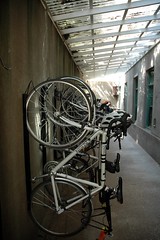
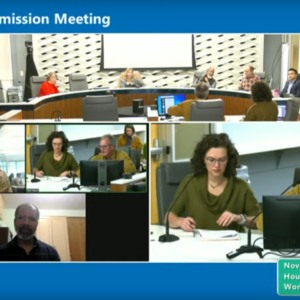
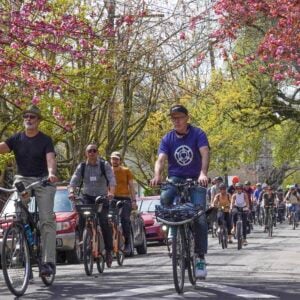
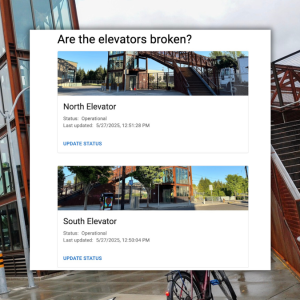

Thanks for reading.
BikePortland has served this community with independent community journalism since 2005. We rely on subscriptions from readers like you to survive. Your financial support is vital in keeping this valuable resource alive and well.
Please subscribe today to strengthen and expand our work.
Charts! Graphs! Details about workplace benefits! A post after my own heart!
But that graph at the top of the post represents cumulative payouts, right? Does that mean that OHSU expects to hand out less in 2011 than it did in 2010?
If so, is it related to the new computerized reporting system pictured?
That’s possible – with the online system, you have to record each trip the day it happens, and if you don’t, you’re out of luck, so it takes more initiative on each person’s part to make sure they’re recording it. Previously, there were punch cards that could be punched on the tram or at a number of places around campus. I’ve just bookmarked the portal on my phone and log my trip on the way up the tram each morning.
To be clear, the main reason it requires more incentive on the part of each person now, is you have to be at a computer to log the trips, before, you could just get your card punched on the way in to your building or going up the tram or whatever. But a lot of people don’t sit at a computer for their job, so it can be more difficult to punch in *at* work, and if you forget to do it after, you’re out of luck.
You are correct that not all program members have easy access to a computer. The problem with any program is creating equitable access for all members. In shifting trip logs (which have always been once a day) from a manned punch station to a website, we found that more access points were available to members via public computers & kiosks than the limited areas & hours of punch stations. The 1st month after launch, 83% of surveyed members said they were able to log a trip in under 30 seconds. There was a measurable increase in access overall, but yes there’s always room for improvement.
Michael. Good question. Here’s what John Landolfe of OHSU says about that,
Thanks, Jonathan. So if that chart at the top is cumulative, it actually looks as if John expects OHSU to give out 32% less money this year than it did in 2009:
– $35,152 in 2009
– $50,163 in 2010
– $23,895 in 2011
That’s not a criticism of this awesome program or of John’s wanting to offer conservative estimates of future growth. But if payouts are shrinking that sharply, I think that’s useful information.
Actually, Michael, it’s not the cumulative but the annual payout. So last year’s payout alone was over $150k. I’ll look forward to answering some more questions this afternoon when I return from a transportation fair.
Ah, cool. That makes more sense.
Does money make potential riders more interested and less concerned? I like what OHSU is doing. It would be interesting to see what gets more people on bikes and which is more cost effective: Lots of expensive infrastructure or cash in the pockets of riders?
$600 a year to bike commute, that’s a pretty sweet deal!
I agree it’s a great program. But it doesn’t factor in to the reasons I ride to work, and to be clear that’s $50 before the taxes are taken out.
As I always tell people, it’s nice to get paid for something I’d do for free.
So not only does it cost the incentive $’s but there can be an impact on employee productivity with everyone having to log the data every day.
Was there any infrastructure that had to be added to handle the increase in ridership, racks, etc?
What is the true cost of the program?
I know I’ll get pilloried for asking, but it’s like anything else if you don’t ask you’re only getting part of the story.
compared to $20K or more per *free* car parking space for employees who drive, the money spent on incentives for cycling is peanuts.
To be fair, car parking at OHSU is not free for any staff or faculty, only patients (in some cases) – it’s actually quite expensive.
A lot of dept’s pay for their faculties parking spots. A dept. general funds come from F&A from their faculties NIH grants. So in reality the tax payer paying for them to park.
meh:
The program was started specifically to mitigate a parking issue, which is that there is not nearly enough for everyone who drives to OHSU (staff, faculty, patients, visitors, etc). Building more parking (which actually isn’t even possible on the hill due to City of Portland regulations), plus the enormous hassle, and possibility of not having parking available for patients costs them way more than this program.
I can’t imagine the 10 seconds it takes to login and log the trip effects employee productivity much.
They have added some parking, but I have a feeling that would have happened anyway, regardless of the program.
I’m not saying your concerns aren’t valid, but I honestly don’t think there was much cost to this above the actual money they are handing out. Maybe if John Landolfe is around, he can comment more specifically on that?
Well, I’d hope you don’t get pilloried because those are perfectly good questions. Productivity: the site is designed for a user to log a trip in under 10 seconds. Timewise, I’d estimate it about equal to asking a coworker how their morning’s going.
Costs: the facilities are an ongoing upkeep. A parking budget at an institution of OHSU’s size is well into the millions in construction, upkeep, administration, & enforcement. If you spend $100,000 on a bike cage, it looks like a large amount on its own but the savings is, in fact, huge. The site (developed by Isite Design, quick plug), has significant start up costs but our financial analysis showed this would be dwarfed by the labor and material costs of a punch card system in the long run.
Does the funding get sourced from parking revenue, or somewhere else?
Hi Robert, missed your question on my 1st scan through the comments. The program is funded from Transportation & Parking’s general budget (roughly $13.5 million per fiscal year), the revenue streams of which are parking, transit passes, and related products. The bike incentive program represents about 1% of this budget.
The graph should NOT be cumulative because we are interested the (hopefully) increased rate of money given out — which is the point they are trying to illustrate. From the text in the article, it is still unclear whether it is cumulative. It would be much clearer to have money given out PER year so that the change between each year can been observed.
I’m a regular patient there and I bike to AT LEAST half of my appointments. (Terwiliger just might be my favorite road in all of Portland. Seriously.) Can they trim my medical bill a bit?
On the other hand, I once climbed up Sam Jackson Park Blvd instead of Terwiliger, emphasis on “once”, and was fairly sweaty when the nurse examined me. She couldn’t have been happy. I learned my lesson that day.
A couple of minor corrections to the story and comments above.
1. You don’t get to choose the program. If you have parking, you get one free month. This is anywhere from $110-$169+. If you have a subsidized TriMet pass, you get one free month. This is $35. If you have neither, you get $50 pay, minus taxes.
2. It takes 30 rides to qualify for an incentive. You can only ride Monday-Friday – weekends don’t count. There are only about 22 work days in a month, or 230 work days a year. If you never take sick leave or vacation, and bike every day of the year, you get 8.3 incentives.
Combining 1 & 2, for me, with a TriMet pass, I get about 6 incentives a year, for a total of about $210. Not bad, but nowhere near the $600 someone cited in the comments above. And someone with a $50 incentive will get nearly the same, after you deduct taxes. Only drivers with parking permits get more.
3. I’m 99% sure the chart shows annual payouts, not cumulative.
The biggest drawback to the new online system, compared to the cards, is that there is no flexibility. If you forget to log one day, you’re out of luck.
All that said, I’m happy to have the incentives and grateful for all the work John L and others in the transportation office are doing to support biking at OHSU.
As someone who takes the hill I prefer the current system far more than the previous tram-centric punch card system.
Chris’s clarifications are correct. Thanks Chris! Because it sometimes causes confusion, the parking incentive is MORE & the TriMet LESS because they’re both refunds of money the employee has already paid toward those programs (refunds). For example, we’re saying that if you have an annual parking permit, if you bike the whole month of August, we’ll give you a refund on what you’ve already paid. The transit one is also IN ADDITION to the TriMet/C-Tran subsidy OHSU provides employees ($600+).
Note that, if you bike the whole month of August, you do not get a full refund. There were only 21 weekdays in August in 2010, and it takes 30 trips to get an incentive.
Outside of the downtown, the Lloyd district and OHSU, all regional employment/industrial areas offer employees free parking…the biggest, most expensive commute subsidy around by far. Maybe Michael can do us a back of the envelop estimate of the $ value of all that industrial land we hear is so scarce that is put to that use. Just on Swan Island the number must be in the $ millions.
Dude, Lenny, I already wrote on that envelope! Just for Swan Island, though. Citywide, my formal estimate is approximately $9.6 bajillion.
Yeah, I actually have to *pay* to bike to work, since I cheat and take the MAX in the morning so I don’t arrive tired and sweaty.
In reality, even when paying $2.30 (or whatever it is) for a one way MAX ticket, it’s probably cheaper than driving, since a round-trip commute would use roughly a gallon of gas, at something like $3.80/gal, plus wear/tear.
Props to OHSU for actually doing incentives. Sure it might not be a lot, but it covers consumables like tires, cleaning supplies, maybe a pair of shorts and some gloves, or whatever.
You gotta be careful when bikes are onboard the tram. One ran into my nuts as the tram was getting over “the hump” tower as the tram swung wildly to and fro.
is there some way in which anyone verifies the info that these employees are logging in?
I imagine the possibility of losing a job over a relatively small amount of money will keep honesty in line.
Unless you bring in tens millions of grant/clinical dollars this is exactly the kind of infraction OHSU would fire you for in a *heartbeat*.
Realistically, people could cheat under the old punch card system too. Just get a punch and off you go.
Trust is a good thing, actually.
Are, it’s about 90% trust, 10% fraud deterrents. The web application keeps an electronic fingerprint on every bike trip and users provide their supervisor’s contact information. I’ve personally done bike counts on some of the worst days of the year (we had over 200 trips logged on a day when it was below freezing out) just to ensure our numbers match up. I was surprised to find that we really did have some 200 bikes on campus.
An employer also expects an employee not to walk off with property, cheat on timecards, steal from the cafeteria, etc. We find that most people have been honest.
Sounds like they need more bike parking at the downhill end of the tram. Wouldn’t it be easier and cheaper to provide secure bike parking there, rather than encouraging everyone to take bike ON the tram and park on top of the hill?
Some people will always want to ride down the hill (Wheee!), but there it wouldn’t take much space to provide more bike parking at the bottom.
ohsu should give extra cash to riders who take the hill.
😉
Here’s my two cents: I live near Lloyd Center and work on the Hill. I can’t afford (and don’t want) to drive and park. The bus takes nearly an hour. My bike commute takes half of the time the bus takes (ok, yes, I’m slow) and is often the best part of my day. Those are incentives to ride; the money is icing on the cake.
As far as taking the bike on the Tram, I do because for one thing riding down the hill is fun and faster than taking the Tram down to waterfront. Also, I have had too many bikes stolen to leave mine chained up at the bottom. She is parked in my office where I can keep a loving eye on her all day long. 🙂
there are secure bike rooms all over OHSU, including the parking garaage at CHH. talk to the transportation dept.
I would guess that $30.00 of that $50.00 per month is added to payroll, per IRS regulations (only $20.00 per month is allowed free of tax, and that’s not combinable with any other qualified transportation fringe benefit– either you get $20.00 free for biking, or parking/vanpool/transit pass).
Is it grossed up, or is that the gross added to taxable wages? If it’s added as gross, then the employees are getting $30.00, less taxes. If it’s grossed up, the employer’s covering the taxes, essentially.
Or is it $50.00 added to gross/grossed up?
More details, please.
It is indeed $20 tax-free, $30 taxed. Our program predates the Bike Reimbursement language in the tax code so, at current, it is not an optimal fit.
Thanks for the clarification!
Gee, can a tax incentive be far behind?
No. What’s allowed by the IRS is all that we’ll get.
The worst part is it cannot be combined with any other qualified transportation fringe benefit– so if you had a transit pass fb from your employer, you wouldn’t also get to take advantage of the bike commuting fb. But you *can* combine that transit pass with a parking fb from your employer. Sucks.
Awesome program! From NE Portland (~NE40th), it’s the fastest way to get to work at OHSU. Tram up, ride down. I used to get the bus pass but, over the years, I found it was way cheaper to buy a book of tickets and keep it in my mess. bag. I almost never use them.
Where’s the ‘like’ or “I’m a fan” button?
Hey entrepreneurs! Anyone want to start a bike shop at the foot of the tram? Please? I love my neighborhood bike shop but being able to drop my ride off at the start of the day and pick her up on the way home would be golden!
John Landolfe has done a great job on this program!